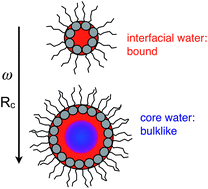Dynamics of water confined to reverse AOT micelles
Abstract
We use quasi-elastic neutron scattering (

* Corresponding authors
a
Institut für Festkörperphysik, Technische Universität Darmstadt, Darmstadt, Germany
E-mail:
tinka.spehr@physik.tu-darmstadt.de
Fax: +49 6151 164883
Tel: +49 6151 162483
b Institut Laue-Langevin, 6, rue Horowitz, Grenoble, France
c Jülich Centre for Neutron Science, Forschungszentrum Jülich, Jülich, Germany
d Spallation Neutron Source, Oak Ridge National Laboratory, Oak Ridge, TN, USA
We use quasi-elastic neutron scattering (

 Please wait while we load your content...
Something went wrong. Try again?
Please wait while we load your content...
Something went wrong. Try again?
T. L. Spehr, B. Frick, M. Zamponi and B. Stühn, Soft Matter, 2011, 7, 5745 DOI: 10.1039/C1SM05204G
To request permission to reproduce material from this article, please go to the Copyright Clearance Center request page.
If you are an author contributing to an RSC publication, you do not need to request permission provided correct acknowledgement is given.
If you are the author of this article, you do not need to request permission to reproduce figures and diagrams provided correct acknowledgement is given. If you want to reproduce the whole article in a third-party publication (excluding your thesis/dissertation for which permission is not required) please go to the Copyright Clearance Center request page.
Read more about how to correctly acknowledge RSC content.
 Fetching data from CrossRef.
Fetching data from CrossRef.
This may take some time to load.
Loading related content
